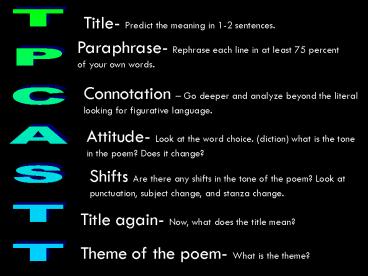TPCASTT Poetry Analysis Technique - PowerPoint PPT Presentation
1 / 13
Title:
TPCASTT Poetry Analysis Technique
Description:
Title Paraphrase Connotation Attitude Shifts Title again Theme of the poem TPCASTT is the method we will be using to analyze poetry. You will TPCASTT a poem assigned ... – PowerPoint PPT presentation
Number of Views:368
Avg rating:3.0/5.0
Title: TPCASTT Poetry Analysis Technique
1
Title- Predict the meaning in 1-2 sentences.
Paraphrase- Rephrase each line in at least 75
percent of your own words.
Connotation Go deeper and analyze beyond the
literal looking for figurative language.
TPCASTT
Attitude- Look at the word choice. (diction) what
is the tone in the poem? Does it change?
Shifts Are there any shifts in the tone of the
poem? Look at punctuation, subject change, and
stanza change.
Title again- Now, what does the title mean?
Theme of the poem- What is the theme?
2
(No Transcript)
3
Title
TPCASTT is the method we will be using to analyze
poetry. You will TPCASTT a poem assigned to you
tomorrow. This is the poem you will research,
and this is the first step in the research paper
process.
Paraphrase
Connotation
TPCASTT
Attitude
Shifts
Title again
Theme of the poem
4
TPCASTTPoetry Analysis Technique
- Shauna Rynn Waters with changes by Abby Beal
5
What is TPCASTT?
- TPCASTT is an acronym of steps used to analyze
poetry. The results of TPCASTT can be used to
write an essay. - There are seven steps in the TPCASTT process.
6
T -- Title
- Ponder the title before reading the poem
- Look at the title and attempt to predict what the
poem will be about. - Using the sample in front of you, lets do this
step now.
7
P -- Paraphrase
- Translate the poem into your own words
- Make sure you understand the literal plot of the
poem. - Write notes in the margin beside each major
section of the poem so you can review these later
8
C -- Connotation
- Contemplate the poem for meaning beyond the
literal level - Look for any and all poetic devices and try to
see how those devices contribute to the meaning,
the effect or both of the poem - Metaphor, simile, personification, alliteration,
onomatopoeia, rhythm, rhyme, symbolism, and
diction - Analyze your sample poem now. Circle these
devices and make margin notes about their
meanings.
9
A -- Attitude
- Observe both the speakers attitude and the
poets attitude (this may or may not be clear) - This, of course, is TONE.
- Remember that these attitudes will probably shift
or be mixed in the poem. Label all you see,
especially if you see a shift.
10
S -- Shift
- Note shifts in speakers or attitudes
- See your handout for more information about
indicators of shifts - Are there any shifts in the poem before you?
11
T Title (again)
- Re-examine the title. Try to see how the title
fits with the work as a whole. - This time, you are interpreting the title, not
just predicting or looking at it literally.
12
T -- Theme
- Determine what the poet is saying
- THIS IS NOT THE MORAL OF THE POEM
- Identify the theme by recognizing the human
experience, motivation, or condition of the poem. - Follow the steps on your handout to help you come
to theme. - Notice that theme is not a trite parable or axiom
- One work may have several possible themes
13
Weaving it together
- Now that you have an understanding of the basics
of the poem, you are ready to TPCASTT your
assigned poem. - You may not need everything youve labeled.































